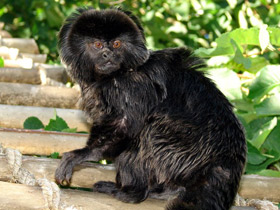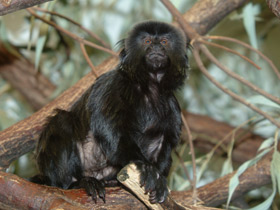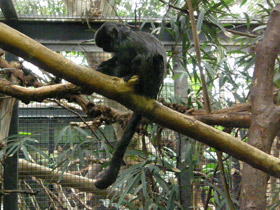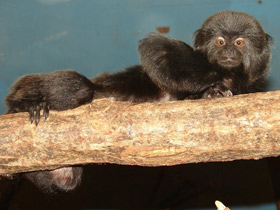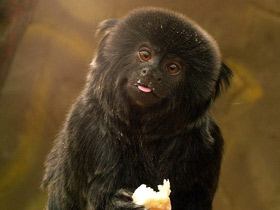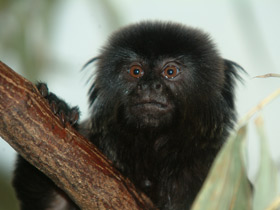The Goeldi's marmoset or Goeldi's monkey (Callimico goeldii)
The Goeldi's marmoset or Goeldi's monkey (Callimico goeldii) is a small, South American New World monkey that lives in the upper Amazon basin region of Bolivia, Brazil, Colombia, and Peru. It is the only species classified in the genus Callimico, and the monkeys are sometimes referred to as "callimicos". The species takes its name from its discoverer, Swiss-Brazilian naturalist Emil August Goeldi.
Appearance and habitat
Callimico goeldii is a species of platyrrhine primate of the family Callitrichidae.
It is the only member of the genus Callimico, named after the Swiss naturalist Emil August Goeldi (1859-1917). Callimico goeldii inhabits the upper Amazon basin in Bolivia, Brazil, Colombia, Ecuador and Peru. These small monkeys have a body length of about 20 cm and a tail of 25-30 cm, and weigh between 355 and 556 g. The Callimico goeldii's black fur is thick and silky, with long, spiky hairs growing on the back and sides of the head, forming a mane that falls to the neck and shoulders.
Taxonomy and evolution
Goeldi's marmoset was first described in 1904, making Callimico one of the more recent monkey genera to be described. In older classification schemes it was sometimes placed in its own family Callimiconidae and sometimes, along with the marmosets and tamarins, in the subfamily Callitrichinae in the family Cebidae. More recently, Callitrichinae has been
(re-)elevated to family status as Callitrichidae.
Molecular phylogenetics shows that Callimico goeldii evolved from an ancestral callitrichine and shares this origin with marmosets making them sister taxa. One evolutionary argument to account for their differences, states that Callimico goeldii conserves primitive traits such as single births and a third molar lost in many marmosets. Alternatively, another evolutionary argument indicates that Callimicos came from a two-molar marmoset and reintroduced the remote traits, which in either case selectively give them the ability to access to different resources and occupy different niches. Similarities in delayed embryonic development and secondary limb-bone ossification between Callimico goeldii and marmosets are evidence of their close evolutionary relationship.
Nutrition
Callimico goeldii are omnivorous and feed on fruits, berries and mushrooms; insects (moths, grasshoppers), spiders and small vertebrates (lizards, frogs and snakes). They forage in trees and on the ground, drink from water sources in dry periods and lick drops from leaves and shoots in wet periods.
Lifestyle
Callimico goeldii are diurnal and mainly arboreal. They climb easily up tree trunks vertically, jump from tree to tree and turn in flight; they can descend from a tree trunk upside down or vice versa, backwards. When jumping, Callimico goeldii use their hind limbs to produce a basic thrust and give inertia to their body. Thanks to their momentum, they are able to jump up to 4 metres without losing height. These primates prefer to stay in the lower stratum of the forest (1-5 m above the ground), but can climb higher in search of food. Monkeys use scent glands located in the abdomen to give their body a distinctive odour. They do this by stretching their limbs under the arched body, or by inserting the tail curled into a ring under the body and moving it back and forth under the belly, thereby moistening themselves with urine and scent glands.
Social behaviour and reproduction
These monkeys live in pairs or in family groups of up to 9 individuals. The backbone of the group consists of an adult male, one or two breeding females and their young. The group is very close-knit and cohesive: Callimico goeldii are rarely more than 15 m apart. During resting periods (between feeding and movements), Callimico goeldii spend a lot of time on social grooming: they brush their fur, remove insects and dead pieces of skin. During the day, Callimico goeldii rest 1 to 4 individuals a few metres apart, at night they all sleep together in the dense undergrowth or in a hollow tree, huddled closely together. The breeding season runs from September to November and gestation lasts between 145 and 157 days. The female gives birth to a calf weighing between 30 and 60 g and feeds it with milk for up to two months. The mother carries the calf for the first two weeks, the father for the third week, and then any member of the group. At one month of age, the calf begins to taste solid food, and by 7 weeks of age it has almost completely transitioned to adult food.
Development
From birth to about 18 months old, callimicos grow faster than other marmosets in part because the energy they would otherwise invest on thermal regulation and activity costs if they were not carried by their mothers is instead directed to growth. Likewise, a longer lactation period is also responsible for a faster development. Growth rate and weight gain is similar in both male and female infants and juveniles.
Callimico goeldii on the Red List
Callimico goeldii is rare throughout its range. The species is included in the IUCN Red List as endangered.
Subspecies
- Callimico goeldii pygmaea;
- Callimico goeldii niveiviventris.

















